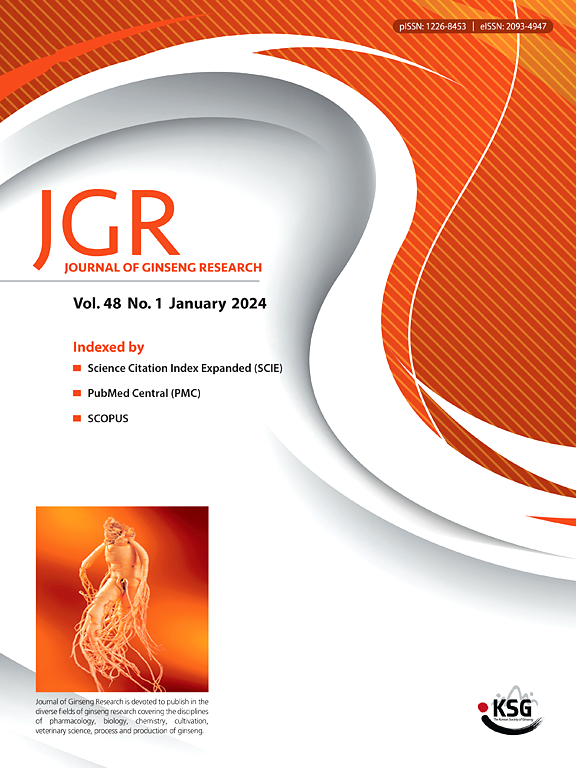人参皂苷Rg1在冠状动脉疾病中的作用及机制研究进展
IF 5.6
2区 医学
Q1 CHEMISTRY, MEDICINAL
引用次数: 0
摘要
冠状动脉疾病(CAD)是全球发病率和死亡率的主要原因,需要创新的治疗策略。在中医中被尊为“草药之王”的人参因其对心血管的益处而受到科学界的关注。在其生物活性成分中,人参皂苷Rg1作为一种有效的治疗候选物脱颖而出。本文综述了目前关于Rg1在CAD管理中的多层面机制的研究,包括其在增强内皮功能、抑制平滑肌细胞增殖、调节炎症、调节脂质代谢、预防血栓形成和促进血管生成方面的作用。此外,Rg1通过减轻缺血性心肌损伤、减轻心肌肥厚和预防纤维化表现出心脏保护作用。尽管临床前研究结果很有希望,但Rg1的临床转化受到诸如生物利用度差、潜在药物相互作用和临床试验数据有限等挑战的阻碍。这篇综述强调需要严格的临床研究来验证Rg1的有效性和安全性,为将其纳入CAD治疗方案铺平道路。本文章由计算机程序翻译,如有差异,请以英文原文为准。

Roles and mechanisms of ginsenoside Rg1 in coronary artery disease: Progress and perspectives
Coronary artery disease (CAD) is a leading cause of morbidity and mortality globally, necessitating innovative therapeutic strategies. Panax ginseng Meyer, esteemed in traditional Chinese medicine as the “King of Herbs,” has garnered scientific attention for its cardiovascular benefits. Among its bioactive components, ginsenoside Rg1 stands out as a potent therapeutic candidate. This review consolidates current research on Rg1's multifaceted mechanisms in CAD management, including its roles in enhancing endothelial function, inhibiting smooth muscle cell proliferation, modulating inflammation, regulating lipid metabolism, preventing thrombosis, and promoting angiogenesis. Furthermore, Rg1 exhibits cardioprotective properties by mitigating ischemic myocardial injury, reducing myocardial hypertrophy, and preventing fibrosis. Despite promising preclinical findings, the clinical translation of Rg1 is hindered by challenges such as poor bioavailability, potential drug interactions, and limited clinical trial data. This review underscores the need for rigorous clinical studies to validate Rg1's efficacy and safety, paving the way for its incorporation into CAD therapeutic regimens.
求助全文
通过发布文献求助,成功后即可免费获取论文全文。
去求助
来源期刊

Journal of Ginseng Research
CHEMISTRY, MEDICINAL-INTEGRATIVE & COMPLEMENTARY MEDICINE
CiteScore
11.40
自引率
9.50%
发文量
111
审稿时长
6-12 weeks
期刊介绍:
Journal of Ginseng Research (JGR) is an official, open access journal of the Korean Society of Ginseng and is the only international journal publishing scholarly reports on ginseng research in the world. The journal is a bimonthly peer-reviewed publication featuring high-quality studies related to basic, pre-clinical, and clinical researches on ginseng to reflect recent progresses in ginseng research.
JGR publishes papers, either experimental or theoretical, that advance our understanding of ginseng science, including plant sciences, biology, chemistry, pharmacology, toxicology, pharmacokinetics, veterinary medicine, biochemistry, manufacture, and clinical study of ginseng since 1976. It also includes the new paradigm of integrative research, covering alternative medicinal approaches. Article types considered for publication include review articles, original research articles, and brief reports.
JGR helps researchers to understand mechanisms for traditional efficacy of ginseng and to put their clinical evidence together. It provides balanced information on basic science and clinical applications to researchers, manufacturers, practitioners, teachers, scholars, and medical doctors.
 求助内容:
求助内容: 应助结果提醒方式:
应助结果提醒方式:


